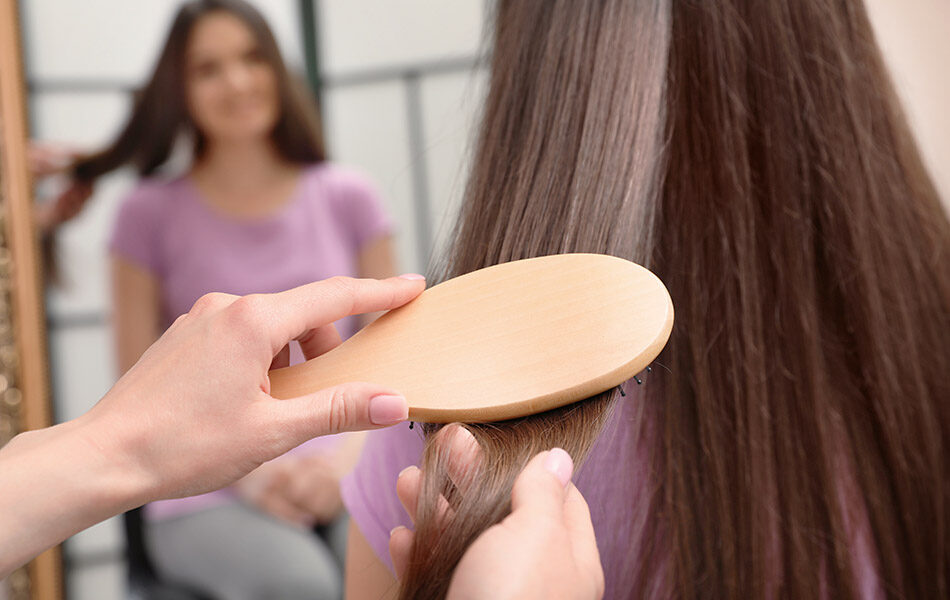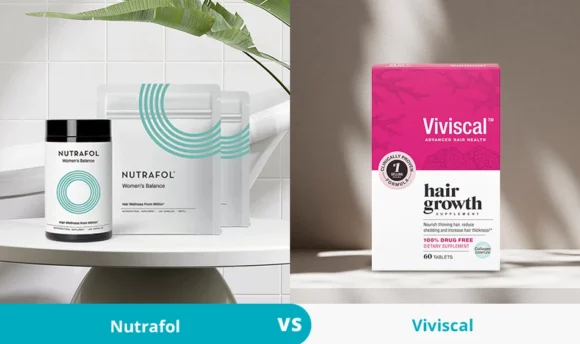How to Make Your Hair Grow Faster? 8 Proven Strategies
Explore the most effective haircare and lifestyle changes to promote faster hair growth.

Long hair has always been something many people desire. It’s the most important feature of our appearance. It’s about more than just looking good and reflects our personality and confidence.
While some people have hair that grows quickly and effortlessly, others may find that it takes months or even years to grow a couple of inches.
The hard truth is that no secret miraculous remedy can offer you the most coveted hair length. However, you may incorporate a few techniques into your haircare routine to stimulate hair growth and thickness.
You don’t have to use expensive products or undergo risky treatments. These hair growth techniques are natural and effective.
What’s the Fastest Way to Grow Hair? Learn the Truth
How fast your hair grows depends on several factors, some you can control and some you can’t. These include genetics, diet, age, hormonal fluctuations, stress, haircare practices, scalp health, medications, and other health issues.
Men’s hair tends to grow faster than women’s. This is because testosterone makes male hair strands thicker. Thicker and coarser hair grows longer than thin and fine hair.
Pregnancy can speed up the growth rate of a lady’s hair due to the highest estrogen concentration. This hormone surge causes hair follicles to remain in their normal growth phase (anagen phase) longer than usual. It may also cause increased hair thickness, reducing hair breakage.
Hair also grows faster from the age of 15 to the late 20s and then slows significantly, especially with menopause. Changes in your hormones can cause your hair to grow slower as you age. Some of your follicles may also stop producing hair entirely, resulting in total hair thinning or balding in those places.
That said, you can do a few things to keep your hair in good health and help it grow while you retain length.
8 Proven Tips on How to Grow Your Hair Faster: Get Longer, Thicker Strands
While there are no miracle products that can make your hair grow faster and more naturally, there are some techniques you can use to help your hair grow faster. Discover 8 proven tactics.
#1 Do scalp massage and treatment
A scalp massage is the most convenient approach to stimulate hair growth. It not only feels wonderful and relaxing, but it also increases blood circulation, stimulates the scalp, and may enhance hair thickness.
Stretching during a massage encourages hair thickness and growth in the dermal papilla cells located at the base of the hair follicle. These cells are required for hair production, shedding, growth, and regrowth.
It is said that turmeric and cinnamon might enhance blood circulation in the scalp and support hair growth. Mix these spices in the carrier oil and massage your scalp regularly to see the results faster.
Regular scalp massage can also help you ease tension and anxiety and stress reduction results in healthier hair.
#2 Choose the right shampoo
Making your shampoo work for you is one of the simplest ways to accelerate hair growth. The correct shampoo promotes hair growth by strengthening the hair shaft, reducing breakage, eliminating dead skin cells, and cleaning the scalp.
Choose a growth-promoting shampoo that encourages the overall health of your scalp, hair cuticle, and follicle. The scalp is necessary for the growth and maintenance of strong, healthy hair. For maximum hair health and growth, you must ensure that it is properly nourished and managed.
Choose a formula that contains stimulating ingredients such as zinc, biotin, peppermint, niacin, and caffeine. These increase blood flow to the scalp and nutrient delivery to the hair follicle, which promotes hair growth.
To avoid damage and frizz, it’s also critical to learn how to dry your hair after shampooing. You can use a microfiber towel or a cotton t-shirt to dry it, or you can let it air dry. How you dry your hair can have an impact on how long, strong, and beautiful it looks.
#3 Trim your hair frequently
Damaged hair limits the growth of new hair. Trimming your hair regularly is important. If left untrimmed, split ends can cause your hair to become lifeless, dry, and tangled. Trimming hair also helps prevent hair breakage.
Conditioning or caring for your hair doesn’t miraculously fuse back your split ends. The longer you leave them, the more each end splits into two or three parts, hindering the growth of your hair.
Split ends are also a bit brighter in color. This makes the overall appearance of your locks to be discolored or uneven.
Unless you trim the split ends, no amount of hair masks or spa treatments will restore the shine to your hair.
#4 Get your stress levels down
Stress affects the body in several ways and can cause hair fall. Stress may increase your chances of developing alopecia areata, where your immune system destroys hair follicles. It may also cause trichotillomania or a strong desire to pull out your hair.
Stress hair loss is also caused by the stress hormone cortisol, which causes your hair to enter a resting phase. You may take a long time to notice the shedding after a stressful event.
Try yoga, meditation, and other stress-relieving techniques to help keep your stress levels minimal. Get eight hours of sleep per night and engage in soothing activities.
#5 Eat foods that stimulate hair growth
While you can’t change some factors influencing the growth of your hair, such as age and genetics, you can control your diet. Food, vitamins, and minerals are essential in hair follicle growth and cellular renewal.
A diet deficient in nutrients can result in hair loss. The above study links the deficiencies in vitamins B12 and D, iron, riboflavin, biotin, and other nutrients to hair loss.
Consuming a well-balanced diet high in these vitamins and minerals ensures your hair gets all the nutrition it requires. It may also help hair grow strong and long, especially if you’re prone to hair loss due to poor nutrition.
Foods high in protein and amino acids are necessary for growing healthy and long hair. A protein-rich diet improves the keratin in your hair. And because keratin is a type of protein, prioritize protein in your diet to support healthy growth.
To maintain glossy, long hair without adding extra calories to your diet, eat lean, healthy meals like eggs, chicken breast, Greek yogurt, or plant-based protein.
Consume spinach and other dark, leafy greens, legumes, whole grains, and seafood to maintain adequate mineral levels. When your iron and zinc levels are low, you may notice graying hair, delayed growth, or even hair loss.
#6 Add supplements to your diet
Nutritional deficiencies can also hinder hair growth. Even if you follow a balanced diet, the amount of some minerals may still be insufficient, therefore, you should take high-quality supplements for hair growth.
Biotin and vitamins A and C may help in hair growth. Eating enough omega-3 fatty acids may also benefit your hair.
Biotin is a form of vitamin B whose sufficiency has been shown to promote healthy hair. A lack of biotin can also cause hair loss.
Omega-3 fatty acids have anti-inflammatory effects. They protect the hair follicles from inflammation, a major cause of hair loss. Omega-3 fatty acids also protect body cells and maintain your scalp healthy.
Vitamin C keeps your hair moisturized and prevents damage. Its antioxidant properties also protect the hair from free radical damage. Vitamin A supports the growth of cells, which, in turn, promotes hair growth.
#7 Avoid bleaching and heat styling
Excessive use of styling tools such as blow dryers, curling irons, and flat irons can cause your hair to become dry and brittle. You should use such devices sparingly and at low temperatures. If you must use them, ensure you use heat protectants to prevent damage.
You should also avoid using bleaches. Hair bleaches cause considerable hair damage by opening up the cuticles. Breakage and split ends are more common in chemically treated hair. The fewer chemical or color treatments you use, the better and faster your hair will grow.
While brushing your hair is necessary, doing it too frequently might harm your strands. The intensive friction of hair brushing might break your hair strands and slow their growth. Gently brushing your hair stimulates the scalp and distributes the natural oils down the length of strands. Extreme brushing may also lead to traction alopecia.
#8 Opt for a silk pillowcase
Use silk pillowcases instead of cotton pillowcases. Cotton pillowcases pull your hair’s exterior cuticle layers, making it more prone to frizz, breakage, and damage.
Silk is more smooth and produces less friction. You will wake up with fewer tangles if you use a silk pillow cover. You may also use a silk scarf if you want to keep using your current pillowcase.
How to Grow Hair Back?
You can use techniques and treatments to regrow your hair, starting with a scalp massage. This reduces hair loss and promotes growth by increasing blood circulation to the scalp, which promotes healthy follicles.
You can use essential oils such as peppermint or carrier oils, for example, argan oil, in massaging your scalp. They are effective topical treatments for hair loss because they stimulate the hair growth phase of your cycle.
Vitamin supplements, eating a well-balanced diet, and staying hydrated are effective ways to enhance your immune system and promote hair regrowth.
Exercising regularly will be beneficial if your hair loss is stress-related. Only 2 miles a day of walking can relieve any stress, anxiety, or depression contributing to hair fall.
You may also notice hair loss during pregnancy, with your hair thinning or falling out more frequently. This can start in your pregnancy journey and continue postpartum.
A well-balanced diet rich in nutrient-dense foods such as fruits, vegetables, whole grains, lean protein, and healthy fats can supply the nutrients needed to promote healthy hair growth during and after pregnancy. It’s also important to stay hydrated during the day by drinking plenty of water.
Stress control is also essential throughout pregnancy. Stress can induce hormonal imbalances, which can result in hair loss. Relaxation techniques can help alleviate stress and encourage healthy new hair growth.
FAQs
On average, hair grows about half an inch each month or about 6 inches yearly. However, several factors can affect hair growth, including genetics, age, gender, overall health, and environmental factors.
Hair growth can be slowed by health problems, vitamin or nutritional deficiencies caused by a poor diet, hormonal imbalances, stress, medications, and extreme heat damage from everyday styling.
Faster hair growth than normal is caused by an increase in male hormones called androgens. Androgens are normally produced in small amounts by all women. But, large quantities of this hormone can cause hirsutism.
See your doctor if you experience little to no growth in a six-month to one year. You should also visit your doctor if you notice severe or unexplained hair loss.
A Word From a Trichologist
While hair growth is possible and following any strategies will promote your hair growth and health, it may take some time to see the results of your efforts. Don’t be discouraged! Putting more love into your hair and how you care for it regularly will go a long way.
Patience is essential because hair only grows around 1/4 inch to 1/2 inch per month. If you’re still having trouble growing your hair after following any hair treatments, know that hormonal factors and genetic predisposition have a role in female pattern hair loss. However, unlike male pattern hair loss, the specific cause of female pattern hair loss is unknown.
See your dermatologist if you are concerned about the rate at which your hair is growing or shedding.
Conclusion
Although you can’t make your hair grow faster in a day or even a week, you can change your routine and eating habits to ensure your hair grows as quickly and healthily as possible.
Remember that the treatments may take several months to provide significant results. Exercise your creativity and blend the techniques as much as you can.
If they don’t work for you, consult your doctor about possible medications or medical procedures.

















































 Select your language:
Select your language: 








